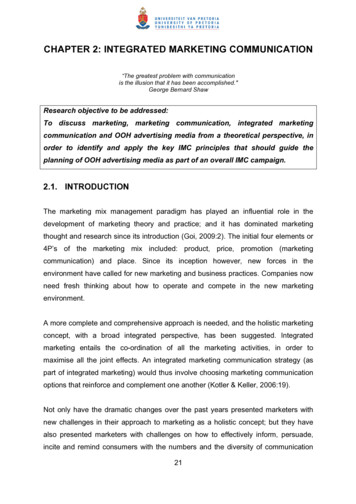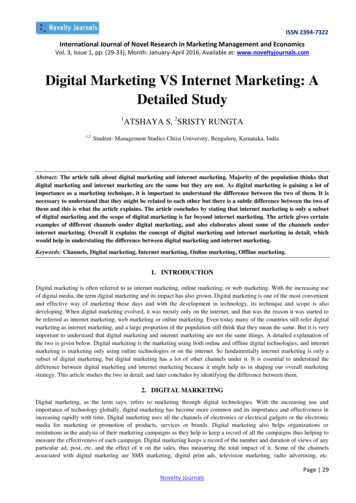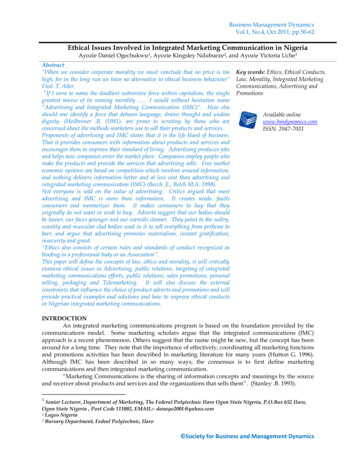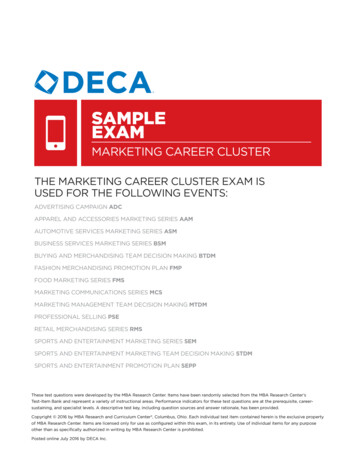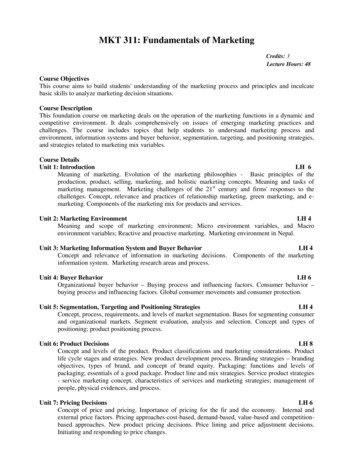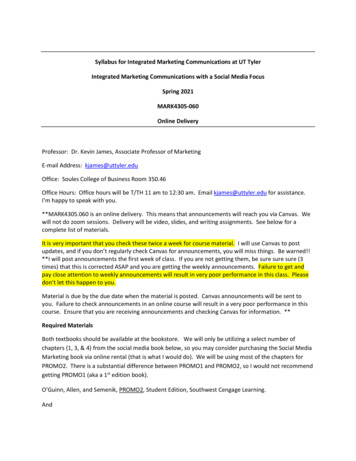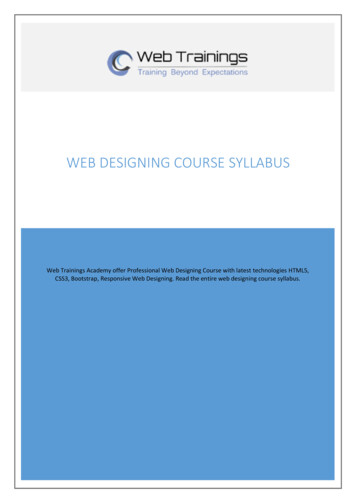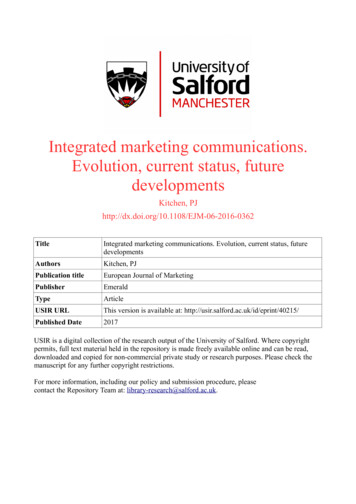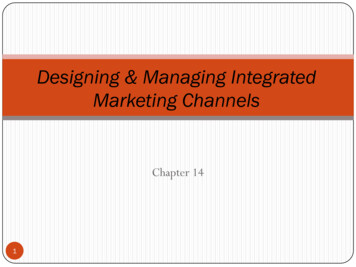
Transcription
Designing & Managing IntegratedMarketing ChannelsChapter 141
Marketing/ Trade/ Distribution ChannelA set of interdependent organizations that are involved in theprocess of making a product or service available for use orconsumption by the business user or consumer.2
Intermediaries Merchants: those who buy, take title to, and resell the merchandise(wholesalers, retailers) Agents: search for customers and may negotiate on producer’sbehalf but do not take title to the goods (brokers, DSAs, etc.) Facilitators: assist in the distribution process but neither take title togoods nor negotiate purchase or sales (banks, transporters,advertising agencies)3
Importance of Channels A Marketing Channel System is the particular set of marketing channels a 4firm employs and decisions about it are among the most critical onesmanagement faces.One of the chief roles of MCs is to convert the potential buyers in toprofitable customers. They just not serve markets they also make markets.MCs also represent a substantial opportunity cost. (Next Slide)Firm’s pricing depends on whether it uses high quality boutiques or massmerchandisers.Firm’s sales force and Ad decisions depend on how much training &motivation dealers need.Channel decisions include relatively long term commitment with otherfirms as well.
Managing Intermediaries- Strategies Push Strategy: involves manufacturer using its salesforce and trade promotion money to induceintermediaries to carry, promote and sell the product toend users. Its appropriate where there is low brandloyalty, the product is an impulse item, brand choice ismade in the store and the product benefits are wellunderstood. Pull Strategy: Involves the manufacturer using5advertising & promotion to induce consumers to askintermediaries for product. It is appropriate when there ishigh brand loyalty, people perceive differences betweenbrands and they make a brand choice before they go tothe store.
Role of Marketing Channels Producers gain in efficiency and effectiveness by usingintermediaries.- Through their contacts, experience, specialisation and scale of operation theyusually offer the firm more than it can achieve on its own.- Producers may lack financial resources & expertise to sell their products on theirown (Wrigley) Bridge major time, place and possession gaps Moves goods from producer to consumers.6
Role of Marketing Channels Intermediaries require fewer contacts to move products fromproducer to consumer (next slide) Transform the assortment of products made by producers into theassortment wanted by the consumers, hence match demand andsupply7
Contact Efficiency8
Channel Functions Gather information about potential customers, competitors and 9others.Develop and disseminate persuasive communication to stimulatepurchasingReach agreement on price & other terms so that title of ownershipor possession may be effectedPlace order with manufacturersAssume risk connected with distribution workSuccessive storage and movement of physical productsThey oversee actual transfer of ownership
Channel FlowsChannel Members are connected to one another by a varietyof flows Physical Flow- forward Payment Flow- backward Information Flow- both ways Promotion Flow- forward Title Flow- forward10
Channel Levels The number of intermediary levels indicates the lengthof the marketing channel Direct/ Zero-level/ Direct Marketing channel(producer selling directly to the consumer) Indirect ChannelTwo-level channel – having two intermediariesThree-level channel – three intermediaries11
Channels for Consumer erWholesaler Agent/BrokerChannelChannelProducerProducerAgents sRetailersRetailersConsumersConsumersConsumers
Channel Intermediaries13RetailerA channel intermediary thatsells mainly to customers.MerchantWholesalerAn institution that buys goodsfrom manufacturers, takes titleto goods, stores them,and resells and ships them.Agents andBrokersWholesaling intermediaries whofacilitate the sale of a product byrepresenting channel member.
2Channel IntermediariesRetailersTake Title to GoodsMerchantWholesalersTake Title to GoodsAgentsandBrokers14Do NOT Take Title to Goods
Corporate retailing It consists of retail stores such as a corporate chain store owned by acorporation, employing central buying, merchandising andpromotion. It could also be a consumer cooperative, retailer cooperative orfranchise organization It achieves economies of scale, greater purchasing power, wider brandrecognition, better trained employees15
Channel Design Decisions Number of intermediaries Exclusive Distribution – least no. of intermediaries Selective Distribution – a few intermediaries Intensive Distribution – As many outlets16
Levels of Distribution Intensity17Intensity LevelObjectiveNumber ofIntermediariesIntensiveAchieve mass marketselling.Convenience goods.ManySelectiveWork with selectedintermediaries.Shopping and somespecialty goods.SeveralExclusiveWork with singleintermediary. Specialtygoods and industrialequipment.One
E-commerce E-Commerce uses a website to transact or facilitate the sale ofproducts and services online. On-line retailers compete in three aspects of a transaction: Customer interaction with the website Delivery Ability to address problems when they occur18
Pure click companies Search engines Internet service providers Commerce sites Sells goods (flipkart) and services (makemytrip)to consumers Transaction sites Content sites Enabler sites19
Brick-and-click companiesBiggest Challenge is Backlash from intermediaries Offer different brands or products on the internet Offer offline partners higher commissions to cushion thenegative impact on sales Take order on the website but have retailers deliver andcollect payment20
Challenges in e-commerce Low conversion rate – failure to complete a transaction for aselected item Absence of pleasurable shopping experience, socialinteraction, personal consultation with a companyrepresentative Fear of security and privacy21
M-Commerce The phrase mobile commerce was originally coined in 1997by Joseph Creedon at the launch of the Global MobileCommerce Forum, to mean "the delivery of electroniccommerce capabilities directly into the consumer’s hand,anywhere, via wireless technology Mobile commerce services were first delivered in 1997, whenthe first two mobile-phone enabled Coca-Cola vendingmachines were installed in the Helsinki area in Finland. The machines accepted payment via SMS text messages. Thefirst mobile phone-based banking service was launched in 1997by Merita Bank of Finland, also using SMS.22
23Products & Services offered through m-commerce Mobile Money Transfer Mobile ticketing Mobile vouchers, coupons and loyalty cards Content purchase and delivery Location-based services Information services – News, Stock quotes, Sports scores,Financial records, Traffic Reporting Mobile Banking Auctions Mobile browsing Mobile purchase In-application mobile phone payments Mobile marketing and advertising
Supply Chain Management A managementsystem that coordinates and integrates all ofthe activities performed by supply chain members into aseamless process, from the source to the point of consumption. Startsbefore physical distribution and means strategicallyprocuring the right inputs (raw materials, components andcapital equipment), converting them efficiently into finishedproducts and dispatching them to the final destination Supplychain perspective helps companies to identify superiorsuppliers and distributors and help them improve productivityand reduce costs.24
Supply Chain Management A managementsystem that coordinates and integrates all of theactivities performed by supply chain members into a seamlessprocess, from the source to the point of consumption. Startsbefore physical distribution and means strategicallyprocuring the right inputs (raw materials, components and capitalequipment), converting them efficiently into finished products anddispatching them to the final destination Supplychain perspective helps companies to identify superiorsuppliers and distributors and help them improve productivity andreduce costs.25
Market Logistics Systems Market logistics calls for Integrated Logistics Systems (ILS) whichinclude materials management, material flow systems and physicaldistribution, aided by IT. Information systems play a critical role in managing market logistics,especially via computer's point-of-sale terminals, uniform product barcodes, satellite tracking, electronic data interchange and electronicfunds transfer. This shortens order cycle time, reduced clerical labor, reduced errorsand provided improved control of operations.26
Activities in market logistics Sales forecasting which helps scheduling distribution, production and 27inventory levelsMaking production plansOrdering of materialsReceipt and storage of materialsConversion into finished goodsUsing finished goods inventory as a link between customers ordersand manufacturing activityTracking finished goods as they flow off the assembly line and passthrough packaging, in-pant warehousing, shipping-room processing,outbound transportation, field warehousing and customer deliveryand servicing.
Market logistics decisions How should we handle orders (order processing) Where should we locate our stock (warehousing) How much stock should we hold (inventory) How should we ship goods (transportation)28
Importance of Channels 4 A Marketing Channel System is the particular set of marketing channels a firm employs and decisions about it are among the most critical ones management faces. One of the chief roles of MCs is to convert the potential buyers in to profitable customers. They just not serve markets they also make markets. MCs also represent a substantial opportunity cost.

